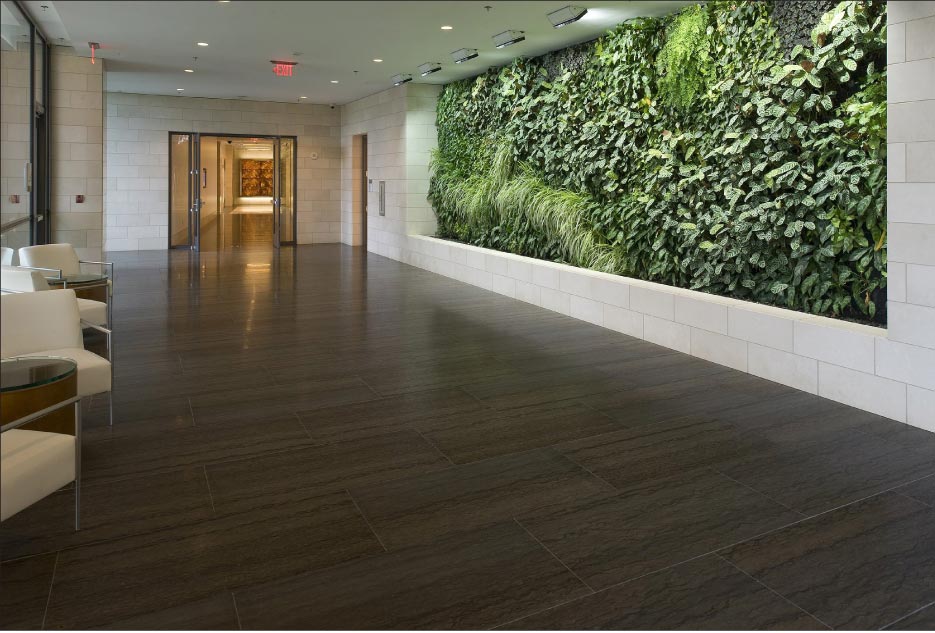Five Limestones to Add to Your Materials Library
Steven Schrenk
Polycor
If your thoughts on limestone are sculptures and boulders in parks, think again.
As varied in color and composition as the spectrum of granites and marbles you love, limestone is a broad category of natural stone with applications as varied as kitchen counters and museum rotundas.
Over the last several years Polycor has quietly (and significantly) expanded its portfolio of limestones to offer architects, designers and landscape architects access to the same stone favored by the creators of the Louvre Museum and the Louis Vuitton Foundation building in Paris, the Empire State Building in New York City and the Royal Alberta Museum in Canada. And what designers are doing with these stones in residential and commercial projects may get you to rethink that Carrara countertop in your next project.
Read on for five varieties of limestone you need in your materials library.
 |
|
Louvre Museum, Paris, France. From amateurs to connoisseurs, art lovers around the world recognize the Louvre as an art Mecca. A work of art itself, it was constructed with French limestone Chassagne. It became the museum we know today in 1793. |
 |
 |
 |
 |
 |
|
Massangis Clair, Beige French Limestone |
Indiana Limestone |
St. Clair Oklahoma |
Saint Pierre Limestone, |
Wallace Creek Limestone, flueri cut and honed |
 |
|
The magnificent Beaux Arts building that is Grand Central Terminal was designed by Reed & Stem and Warren & Wetmore in 1903 with Indiana limestone. |
French Limestone
Last year, Polycor acquired four limestone quarries in the Burgundy region making the famed French limestone stone available worldwide for heritage projects, modern architectural installations, and even residential homes.
This natural French limestone collection includes 13 stones, varied in color and character, from creamy beige to golden yellow, and consistent and uniform to shell inclusions and fossil fragments.
Indiana Limestone
This iconic American stone quarried in Bloomington, Indiana grounds skylines, monuments and universities all over the United States.
Known for its uniformity and consistency, Indiana limestone is available in five varieties plus Full Color Blend, a natural, full range compilation of warm buff colors and medium gray tones. Subtle veining meanders throughout the surface creating a unique movement in this medium grained, standard grade stone.
Polycor added this limestone to its portfolio in 2018 when The Indiana Limestone Company and Polycor merged. Today Polycor quarries more than 2 million cubic feet of Indiana limestone per year for public buildings and private residences.
In New York City, the architects of Grand Central Terminal chose Indiana limestone as a cost effective material that would withstand the ages (and NYC winters) while recalling classic architecture. It endures as a crucial part of New York’s aesthetic and historic identity. You can still see evidence of the architects’ material selection process today.
Saint Clair, Oklahoma Limestone
The versatility of natural stone in building applications is unmatched by any other material, and Saint Clair limestone is a great example. From pavers and carved balustrades to sleek countertops, this light grey limestone elevates both classical and modern designs with subtle veining and color. As Steffen Waite of Red Leaf Group described it, “luxe, yet subtle and quiet.”
(See slipperyrockgazette.net archives, December 2018 edition for a detailed look at this neoclassical mansion project built with French limestone).
You may know Saint Clair as Pacific Mist or Aleutian Marble. Saint Clair is a dolomitic limestone and has a higher concentration of magnesium compared to other limestones – which is why it’s able to take a high polish where other limestones cannot (hence the marble nickname).
Saint Claire limestone is sourced from Polycor’s quarry in Oklahoma.
Saint Clair originates from limestone carbonate rocks originally deposited from seawater at the shores of ancient seas in arid climates, a fascinating fact considering Oklahoma’s distance from the ocean. Limestone beds are formed from the calcium and magnesium of cemented layers of seashells and marine organisms. Think of it like ancient, prehistoric beaches that cemented together over millions of years. Saint Clair is available in fleuri and linear cuts.
 |
|
The lobby of The National Cancer Institute in Bethesda, Maryland, features Saint Pierre linear-cut limestone. |
Saint Pierre Limestone
This Canadian limestone is quarried in Havre-Saint Pierre, Quebec, and is most often used in commercial cut-to-size applications and floor tiles. In a fleuri-cut pattern, this rich chocolate brown limestone creates a warm, homogeneous surface. Recommended for small indoor applications, Saint Pierre evolves from one block to another, making almost every slab unique.
It can also be cut in a linear pattern to expose its distinctive veins.
 |
|
Festival Tower on John Street in Toronto, Ontario features fleuri cut honed Wallace Creek limestone pavers and cladding. |
Wallace Creek Limestone
Wallace Creek, like Saint Clair, is a high density limestone with the properties of an American marble. Characterized by a compact mineral structure, it produces a range of shades when different surface treatments are applied. The sedimentary stone quarried in Canada is also available in a fleuri-cut pattern offering an alternative design element
For residential designers looking to create rich, moody spaces, Wallace Creek offers the character and tones to support industrial and masculine designs. The charcoal grey stone with dark veining is perfect for a gentleman’s bathroom, an industrial kitchen, or even a corporate setting.
In Denver, Colorado, at 555 Office Tower, Gensler used the stone as an anchor for the office building’s lobby redesign.
Each of these natural stones, from the iconic French and Indiana limestones, to the lesser known North American varieties, offer unique character and durability making them suitable options for projects where marble and granite are under consideration. Because Polycor owns its supply chain — from quarry to distribution — it’s able to deliver higher qualities of stone without the lagging lead time of some overseas providers.
See if limestone is right for your next project. Visit Polycor.com to download their complete Spec Sheet Catalog.